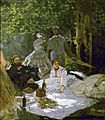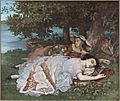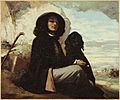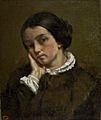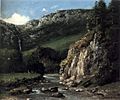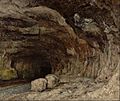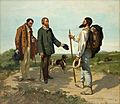Gustave Courbet facts for kids
Jean Désiré Gustave Courbet (born June 10, 1819 – died December 31, 1877) was a famous French painter. He was a key leader of the Realist art movement in France during the 1800s. Courbet is very important in art history for two main reasons. First, he was always ready to try new ideas and ways of painting. Second, his paintings often showed real life and made comments about society. He wasn't afraid to show things that weren't always beautiful or perfect.
Courbet's paintings inspired many other artists. This includes the French Impressionists and Post-Impressionists. Painters like Edouard Manet, Edgar Degas, Vincent van Gogh, and Henri Toulouse-Lautrec were all inspired by Courbet's portraits of people. His landscape paintings also influenced artists such as Claude Monet, Seurat, and Cezanne.
Contents
Early Life of Gustave Courbet
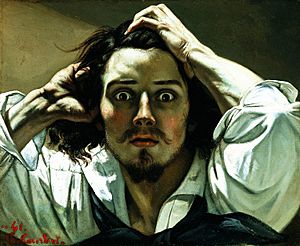
Gustave Courbet was born in 1819 in Ornans, a town in Doubs, France. His parents were Régis and Sylvie Oudot Courbet. His sisters, Zoé, Zélie, and Juliette, were often the first people he drew and painted.
When Courbet was twenty, he moved to Paris in 1839. He first worked in the studios of other painters, Steuben and Hesse. However, he preferred to work on his own. He spent time studying the works of great masters like Goya, Velazquez, and Titian. During this time, he painted several self-portraits. He often went back home to Ornans to hunt, fish, and find ideas for his art in the countryside.
Between 1846 and 1847, Courbet traveled to the Netherlands and Belgium. There, he studied paintings by artists from the 1600s, such as Rembrandt, Franz Hals, and Jan Steen. These artists often painted realistic scenes and portraits of everyday life. They showed ordinary people eating, dancing, writing, cooking, working, and even soldiers. Courbet decided he wanted to paint scenes of ordinary life, just like these artists. He did not want to paint scenes from literature, history, or mythology, which was common for many French artists at that time.
Courbet's Artistic Success
Courbet painted a large picture showing everyday life in his hometown of Ornans. This painting was called After Dinner at Ornans. It shows four men who have just finished a meal, perhaps in an inn. One man is playing his violin, and another is lighting his pipe. Courbet himself is shown listening, with his head resting on his hand. A large dog is sleeping under a chair.
Courbet showed this painting at the Salon Exhibition in Paris. It was a big success! It won a Gold Medal and was bought by the French Government. Because he won the gold medal, Courbet could show his future paintings at the Salon Exhibitions without a jury checking them first. (This rule changed in 1857.) Courbet's art, along with the work of Honoré Daumier and Jean-François Millet, became known as Realism. Like the Dutch painters he admired, Courbet often used broad, rough brush strokes. He also used dark, earthy colors, especially brown, in his paintings.
The Stone Breakers Painting
In 1849, Courbet saw two people working by the side of the road. They were using small hammers to break large rocks into gravel. One was an old man, and the other was a young boy. Courbet decided to paint this scene. He told a friend, "It is not often that one meets with so complete an expression of poverty." He asked them to come to his studio the next morning.
This picture quickly became one of the most famous paintings showing the lives of poor people. Sadly, it was destroyed during World War II in Dresden.
A Burial at Ornans
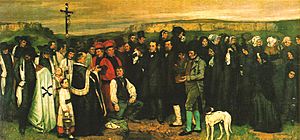
Another important painting by Courbet was shown at the Salon of 1850. This painting also showed a scene from his village. Starting in 1849, he painted the funeral of his great-uncle, who had died the year before. Courbet asked all the villagers who had been at the funeral to come to his studio and pose for him. He painted them one by one until the huge painting was finished. The painting was very large, about 10 by 22 feet (3.1 by 6.6 meters).
A famous artist named Jacques Louis David had once painted a very large picture in a similar way. David's painting was of the Coronation of Napoleon and showed all the important people who were there.
Some people praised The Funeral at Ornans, but others were very angry about it. They thought it was wrong to show the burial of an ordinary man in such a huge painting, as if he were as important as an emperor. They also thought it was wrong to show the poor people of a village, with their old clothes and dirty boots, as if they were as important as lords and ladies. Some art critics even said that Courbet was trying to paint ugliness on purpose. However, many people came to see the picture and liked this new Realist style of painting. Courbet himself said: "The Burial at Ornans was .... the burial of Romanticism."
Courbet became a celebrity. This means he became famous and was written about in newspapers, much like a film star today. People called him a genius and an "outspoken supporter of ordinary people."
In 1850, Courbet wrote to a friend:
...in our very civilized society it is necessary for me to live the life of a savage. I must be free even of governments. The people have my sympathies, I must address myself to them directly.
During the 1850s, Courbet painted many other pictures using common people and his friends as models. Some of these include Village Damsels (1852), the Wrestlers (1853), Bathers (1853), The Sleeping Spinner (1853), and The Wheat Sifters (1854).
The Artist's Studio
Courbet then painted another very large picture called The Artist's Studio. This painting shows about seven years of his life as a painter. He painted himself in the middle of the picture, working on a large landscape painting. All around Courbet are his friends and people from his village. His mother stands to one side of the picture. Another woman is sitting on the floor feeding her baby. A little boy watches the artist, while a white cat plays on the floor.
In 1855, Courbet wanted to show this picture, along with Burial at Ornans and twelve other paintings, at a big international exhibition in Paris called Exposition Universelle. However, his two biggest paintings and another one were not allowed because there wasn't enough room. Courbet was upset. So, he decided to build his own exhibition space nearby and showed forty of his paintings there. Many other artists praised Courbet for this bold move. While some people laughed at him, and the public didn't buy many of his pictures, younger artists heard about what he did and admired him. This included James McNeill Whistler in the United States and Édouard Manet in France.
Other pages
Images for kids
-
Gustave Courbet, A Burial At Ornans, 1849–50, oil on canvas, 314 cm × 663 cm (124 in × 261 in), Musée d'Orsay, Paris. Exhibition at the 1850–1851 Paris Salon created an "explosive reaction" and brought Courbet instant fame.
-
A satirical sketch of Gustave Courbet taking down a "Rambuteau column" (a urinal), caricature published by a popular Commune newspaper, the Père Duchêne illustré
-
Claude Monet, Le Déjeuner sur l'herbe (right section), with Gustave Courbet, 1865–66, Musée d'Orsay, Paris
-
Portrait of Jo (La belle Irlandaise), 1865–66, Metropolitan Museum of Art, a painting of Joanna Hiffernan, the probable model for Sleep
-
Stream in the Jura Mountains (The Torrent), 1872–73, Honolulu Museum of Art
-
The Trellis, 1862, Toledo Museum of Art, Toledo, Ohio
See also
 In Spanish: Gustave Courbet para niños
In Spanish: Gustave Courbet para niños













